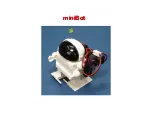
6
1
.
Using a pair of needle-nose pliers, bend
the leads of the resistors at a 90º angle.
2
.
(A) Slip the resistor leads in the through-
holes. (B) Bend the leads on the backside of
the PCB away from each other, securing them
in place for soldering. (C) Solder the leads into
place. (D) Clip the leads after soldering.
3
.
Radial capacitors are polarized and their
leads MUST be inserted into the appropriate
through-hole in order for the circuit to operate
properly. (A) For capacitor “C1”, insert the
longer lead (the positive) into the through-hole
marked with a “+”.
4
.
The grey strip should be facing “C1” on
the PCB. It should NOT BE REVERSED.
5
.
The transistor should be placed in the
same direction as printed on the PCB.
6
.
Capacitor “C3” is also polarized. Position
the capacitor as pictured above, with the
longer positive lead inserted into the through-
hole closest to transistor “Q1”. The upside
down “K” on the capacitor should be facing
outward toward the edge of the PCB as
pictured. Make sure you can see the “K” from
this view point with the transistor to the left.
7
.
You may need to bend the leads of the
motor driver chips so they fit into the through-
holes on the PCB. Make sure you place both
of the these chips with the circle on top facing
each other.
8
.
You can use the putty to hold components
in place while you solder.
9
.
Using needle-nose pliers, grip and gently
snap off the header pins into pairs.
_
TIPS AND TRICKS
K
Содержание Transitional Species Blubber Bot
Страница 2: ......









































